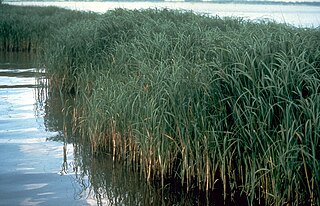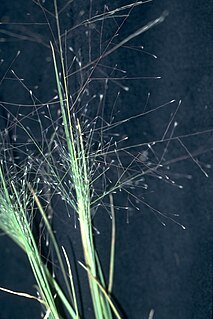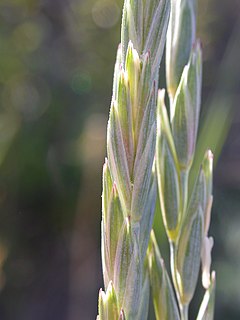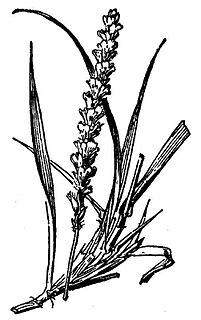
A fibrous root system is the opposite of a taproot system. It is usually formed by thin, moderately branching roots growing from the stem. A fibrous root system is universal in monocotyledonous plants and ferns. The fibrous root systems look like a mat made out of roots when the tree has reached full maturity.

Sporobolus alterniflorus, or synonymously known as Spartina alterniflora, the smooth cordgrass, saltmarsh cordgrass, or salt-water cordgrass, is a perennial deciduous grass which is found in intertidal wetlands, especially estuarine salt marshes. It has been reclassified as Sporobolus alterniflorus after a taxonomic revision in 2014, but it is still common to see Spartina alterniflora and in 2019 an interdisciplinary team of experts coauthored a report published in the journal Ecology supporting Spartina as a genus. It grows 1–1.5 m (3.3–4.9 ft) tall and has smooth, hollow stems that bear leaves up to 20–60 cm long and 1.5 cm wide at their base, which are sharply tapered and bend down at their tips. Like its relative saltmeadow cordgrass S. patens, it produces flowers and seeds on only one side of the stalk. The flowers are a yellowish-green, turning brown by the winter. It has rhizoidal roots, which, when broken off, can result in vegetative asexual growth. The roots are an important food resource for snow geese. It can grow in low marsh as well as high marsh, but it is usually restricted to low marsh because it is outcompeted by salt meadow cordgrass in the high marsh. It grows in a wide range of salinities, from about 5 psu to marine, and has been described as the "single most important marsh plant species in the estuary" of Chesapeake Bay. It is described as intolerant of shade.

Sporobolus heterolepis, commonly known as prairie dropseed, is a species of prairie grass native to the tallgrass and mixed grass prairies of central North America from Texas to southern Canada. It is also found further east, to the Atlantic coast of the United States and Canada, but is much less common beyond the Great Plains and is restricted to specialized habitats. It is found in 27 states and four Canadian provinces.

Hordeum jubatum, with common names foxtail barley, bobtail barley, squirreltail barley, and intermediate barley, is a perennial plant species in the grass family Poaceae. It occurs wild mainly in northern North America and adjacent northeastern Siberia. However, as it escaped often from gardens it can be found worldwide in areas with temperate to warm climates, and is considered a weed in many countries. The species is a polyploid and originated via hybridization of an East Asian Hordeum species with a close but extinct relative of Californian H. brachyantherum. It is grown as an ornamental plant for its attractive inflorescences and when done flowering for its infructescence.

Sporobolus is a nearly cosmopolitan genus of plants in the grass family. The name Sporobolus means "seed-thrower", and is derived from Ancient Greek word σπόρος (spóros), meaning "seed", and the root of βάλλειν (bállein) "to throw", referring to the dispersion of seeds. Members of the genus are usually called dropseeds or sacaton grasses. They are typical prairie and savanna plants, occurring in other types of open habitat in warmer climates. At least one species is threatened with extinction, and another is extinct.

Tussock grasses or bunch grasses are a group of grass species in the family Poaceae. They usually grow as singular plants in clumps, tufts, hummocks, or bunches, rather than forming a sod or lawn, in meadows, grasslands, and prairies. As perennial plants, most species live more than one season. Tussock grasses are often found as forage in pastures and ornamental grasses in gardens.

Sporobolus virginicus, known by numerous common names including seashore dropseed, marine couch, sand couch, salt couch grass, saltwater couch, coastal rat-tail grass, and nioaka, is a species of grass with a wide distribution.

Liriope muscari is a species of low, herbaceous flowering plants from East Asia. Common names in English include big blue lilyturf, lilyturf, border grass, and monkey grass. It is a perennial with grass-like evergreen foliage and lilac-purple flowers which produce single-seeded berries on a spike in the fall. It is invasive to North America and considered a threat to native wildlife.

Muhlenbergia asperifolia is a species of grass known as alkali muhly and scratchgrass. It is native to much of North America, including most of southern Canada, most of the continental United States except for the southeastern region, and parts of northern Mexico. It also grows in South America.

Spartina pectinata is a species of cordgrass known as prairie cordgrass, freshwater cordgrass, tall marshgrass, and sloughgrass. It is native to much of North America, including central and eastern Canada and most of the contiguous United States except for the southwestern and southeastern regions. Its distribution extends into Mexico. It is also present on other continents as an introduced species.

Sporobolus airoides is a species of grass known by the common name alkali sacaton. It is native to western North America, including the Western United States west of the Mississippi River, British Columbia and Alberta in Canada, and northern and central Mexico. It grows in many types of habitat, often in alkali soils, such as in California desert regions.

Sporobolus cryptandrus is a species of grass known as sand dropseed. It is native to North America, where it is widespread in southern Canada, most of the United States, and northern Mexico.
Sporobolus flexuosus is a species of grass known by the common name mesa dropseed. It is native to western North America, where it can be found in the deserts and woodlands of the Southwestern United States and Northern Mexico.

Sporobolus indicus is a species of grass known by the common name smut grass.

Sporobolus vaginiflorus is a species of grass known by the common names poverty grass, poverty dropseed, and sheathed dropseed.

Dalea purpurea is a species of flowering plant in the legume family known as purple prairie clover. Native to central north America, purple prairie clover is a relatively common member of the Great Plains and prairie ecosystems. It blooms in the summer with dense spikes of bright purple flowers that attract many species of insects.

Calamovilfa longifolia is a species of grass known by the common names prairie sandreed and sand reedgrass. It is native to North America, where it occurs from the Northwest Territories to Ontario in Canada and as far south as New Mexico and Kansas in the United States. There are two varieties, var. longifolia being widespread in the species' range and var. magna being native to the Great Lakes region.

Elymus lanceolatus is a species of grass known by the common names thickspike wheatgrass and streamside wheatgrass. It is native to North America, where it is widespread and abundant in much of Canada and the western and central United States. There are two subspecies, ssp. lanceolatus occurring throughout the species' range and ssp. psammophilus occurring in the Great Lakes region. Elymus lanceolatus is a perennial, low growing, rhizomatous grass that actively grows in summer and spring. This plant is native to semiarid regions of the United States.Elymus lanceolatus is polymorphic, capable of growing in high altitude regions of the Rocky Mountains or at sea level near the Great Lakes in the United States. The bloom period for E. lanceolatus is mid-spring, and it is available commercially. Elymus lanceolatus is characterized by its yellow flowers, green or grey leaves, and brown seeds. According to the United States Department of Agriculture (USDA), it has a moderate harvest regrowth rate. Wheatgrass is unique in that in can adapt to fine, medium, and coarsely textured soils in the environment. However, it is shade intolerant, has a medium fertility requirement, and has a medium salinity tolerance. Studies suggest that amounts of soil needed for wheatgrass harvest can be approximated by understanding the plant’s water depletion rate and rainfall amount in the region, which consequently helps reduce drainage.

Pleuraphis mutica is a species of grass known by the common name tobosa, or tobosa grass. It is native to Northern Mexico, and the Southwestern United States, in Arizona, New Mexico, Oklahoma, and Texas.
Sporobolus wrightii is a species of grass known by the common names big sacaton and giant sacaton. It is native to the western United States and northern and central Mexico.



















